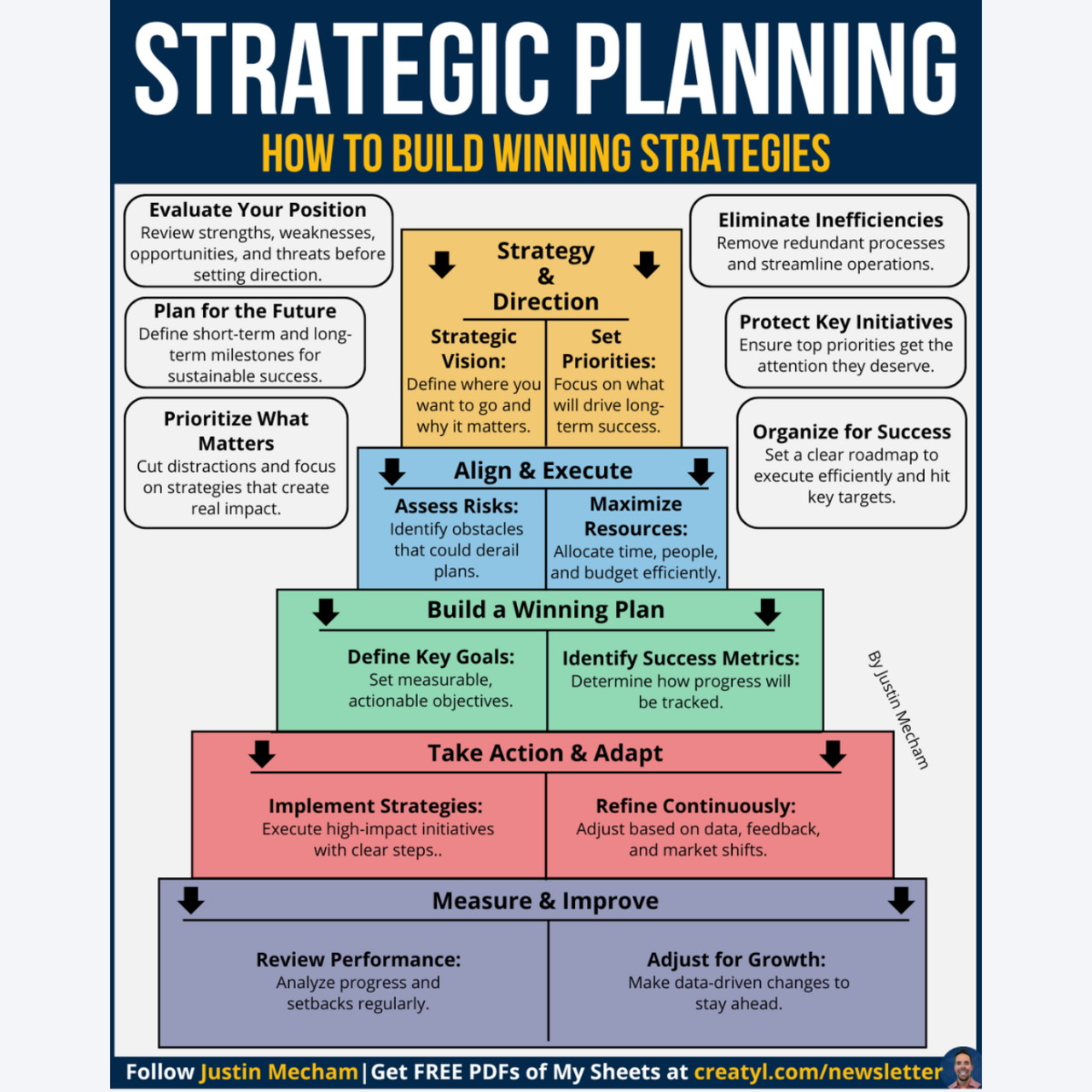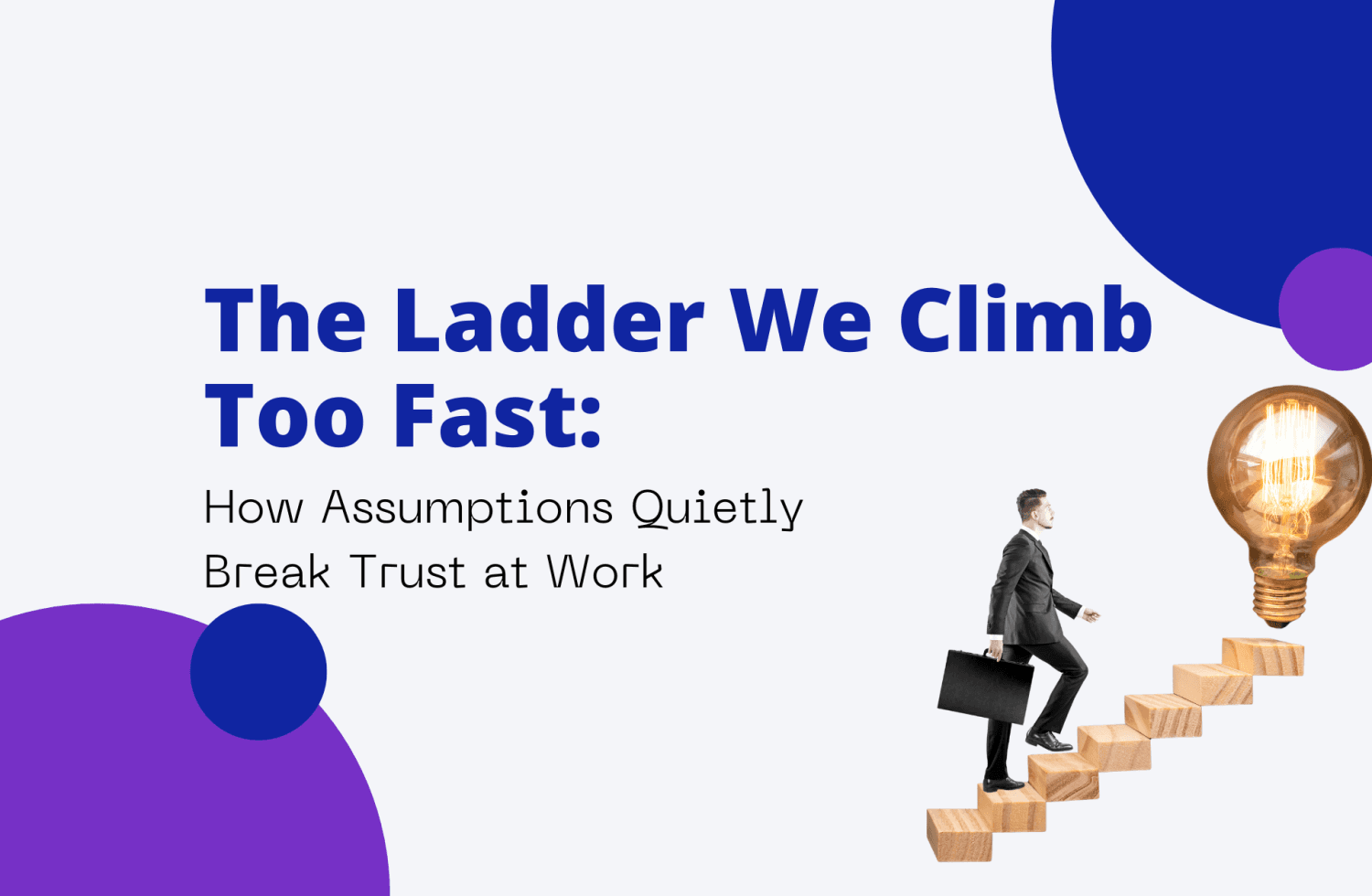Click Here to Download Today's Infographic as a PDF
Let’s be honest: most strategies aren’t really strategies.
They’re wish lists.
They’re long documents filled with buzzwords, disconnected priorities, and overly ambitious targets no one’s actually tracking.
They sound great in kickoff meetings. They look impressive in slides.
But they’re hard to follow, harder to execute, and even harder to measure.
That’s because most strategic plans are built to check a box—not to create momentum.
Real strategy doesn’t feel like a list of chores.
It feels like clarity.
It gives you direction. It frees up your team’s time. It makes decision-making easier—not harder.
This article breaks down what a real strategy looks like—and how to build one that doesn’t just sit on paper but actually drives progress.
1. Start With Direction: Know Where You’re Going—and Why
Strategy without direction is just noise.
One of the first things I ask when I work with a team is this:
“If you could only accomplish one thing this quarter, what would it be?”
That question usually stops the room.
Because buried underneath all the roadmap features, marketing pushes, and cross-functional meetings is often one single goal that matters more than everything else.
And once we name it, everything else gets easier.
This isn’t about simplifying for the sake of it.
It’s about building clarity strong enough to act on.
When you know exactly what you’re trying to achieve and why, decisions stop feeling like guesses.
Without this filter, every idea looks good.
And when everything looks good, nothing moves.
2. Call Out the Risks Before They Derail You
Every smart strategy has one thing in common:
It doesn’t ignore what might go wrong.
Too many teams build their entire plan around the ideal scenario.
And then they freeze when something unexpected happens—because they never planned for it.
That’s why I help teams list out every real obstacle upfront.
Not hypotheticals. Not edge cases. Just the honest, known blockers:
- We don’t have enough engineering hours.
- Our reporting is still broken.
- We’re stretched across too many things.
When those risks are named, they’re no longer threats. They’re part of the strategy.
And now, instead of reacting in a panic later—you’re already building around what’s real.
Ignoring risk doesn’t make it go away.
But addressing it early makes everything feel lighter.
3. Spend People, Time, and Money Where It Actually Counts
Resources don’t drive results.
Prioritized resources do.
I once worked with a team running multiple product experiments at once.
Each one had potential. Each one had a few people involved.
But everything was stalling. Nothing was delivering results fast enough to matter.
So we ran a quick audit.
And it turned out 80% of the impact so far had come from just one of the projects—the one getting the least support.
We made a call: pause the rest, shift the team, and pour into the winner.
Within 30 days, they doubled performance.
The lesson wasn’t about hustle. It was about choice.
Your team can do anything. But not everything.
If you’re not putting your best people, time, and budget behind the things that actually move the needle—you’re spreading progress too thin to feel it.
4. Make the Plan Worth Following
Strategy dies in vagueness.
If your team can’t name the goal—or see how they’re tracking against it—it’s not a plan.
It’s a placeholder.
What works instead?
- Set clear goals in real numbers
- Track them in simple, visible ways
- Review them often enough to stay ahead—not catch up
Let’s say your goal is “increase retention.”
That’s nice, but it’s not helpful.
Now try: “Increase customer retention from 62% to 68% by the end of the quarter.”
Suddenly, people know what success looks like.
Now add: “We’ll track this in our weekly dashboard every Monday.”
Now it’s real.
When progress is visible and measurable, it becomes part of the culture.
It creates alignment naturally.
You don’t have to repeat goals in every meeting—because everyone already sees how the team is doing.
5. Keep It Alive: Plans Should Adapt in Real Time
I once helped a startup that had brilliant OKRs and a thoughtful roadmap.
But by the end of two straight quarters, none of it translated into results.
The problem? They were only checking in monthly.
By the time they saw issues, it was too late to fix anything.
We switched to a simpler rhythm: every team lead answered these three questions every 3 days.
- What’s working?
- What’s stuck?
- What changed?
This simple shift saved them.
They stopped reacting to bad outcomes—and started adjusting fast enough to win.
A static plan might look neat on a timeline, but that’s not how real life works.
The market moves. Customer behavior shifts. Unexpected blockers pop up.
The goal is to stay flexible without losing direction.
Keep the vision locked—but let the tactics bend when they need to.
That’s how you stay relevant. That’s how you stay moving.
A Real-World Example: From Noise to Progress
I worked with a mid-size SaaS team that had 15 “top priorities” listed in their strategic plan.
Everyone was doing something. But no one knew what mattered most.
Deadlines were slipping. Meetings were getting longer. And progress had stalled.
We hit reset. Together, we defined one sentence that described what success looked like:
“Grow product-led signups by 25% in the next 90 days.”
Then we used that one sentence as a filter.
Anything that didn’t support it got paused. From 15 priorities, we cut to 4.
Each project had a clear owner, a measurable goal, and a simple weekly dashboard.
We listed risks: marketing delays, missing analytics, lack of engineering time.
We built solutions before those risks showed up.
Then we added a tight feedback loop—checking in every 3 days with three fast questions.
Six weeks in, they’d hit 80% of their goal.
Not because they worked harder, but because they finally worked with direction.
Meetings got shorter.
Confidence grew.
Work felt clearer.
They didn’t need more output. They just needed to decide what mattered—and stick to it.
Want to Go Deeper?
Here are the best tools and resources to help you build strategies that actually work:
Book: Good Strategy/Bad Strategy by Richard Rumelt
A sharp, no-fluff breakdown of what makes a strategy clear and effective—and how to stop building ones that just sound good.
TED Talk: Your Strategy Needs a Strategy by Martin Reeves
A powerful explanation of how different kinds of environments demand different strategic moves—and why copying what worked last year might fail this year.
Tool: Airtable
A clean, flexible system to track goals, assign ownership, and build visual dashboards for real-time progress. Great for turning strategy into daily action.
These are the best of the best—not generic inspiration, but actual tools that help you build plans people can follow and trust.
The Real Cost of Clarity
Why letting go is the only way forward
The hardest part of strategy isn’t deciding what to do.
It’s deciding what not to do—and meaning it.
That’s where most teams get stuck.
Not because they’re not working hard.
Not because they’re not smart or capable or willing.
But because they try to carry everything at once.
They keep adding. Keep expanding. Keep pushing forward without ever asking, “What’s the thing we’re willing to drop?”
Here’s the truth no one likes to say:
You can’t build momentum without letting something go.
You can’t create clarity while holding onto every possible option.
You can’t find direction while trying to please everyone.
Real strategy is uncomfortable.
It forces hard choices. It asks for trade-offs.
It makes you say no to good things so you can say yes to what actually matters.
But when you do—when you finally cut the noise, drop the extras, and hold the line—you’ll feel the shift.
Your team stops asking what to do.
They already know.
You stop debating every little thing.
You’ve already decided.
You stop “managing” and start moving.
And once you feel that kind of clarity, you won’t ever want to go back.
Download the Strategic Planning Framework (PDF)
If you want to keep this framework close by, I’ve turned it into a clean, printable PDF you can share with your team or use in your next planning session.
It includes the full breakdown of how to build real strategy—from vision to execution—along with simple visuals and a step-by-step flow to follow.
You’ll get a clear reference for every part of the process—no clutter, no guesswork.
Strategy doesn’t have to be complicated.
But it does have to be real.
And this PDF will help you keep it that way.
-
Justin




